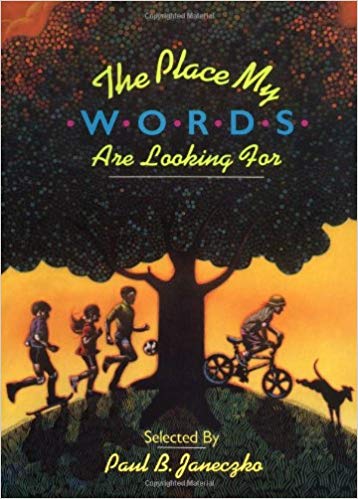by Julie Patterson
 During our Reading like a Writer workshop in November, a table full of middle and upper grade teachers looked closely at a wide variety of poems with Libby Duggan and me, noticing the multitude of craft decisions the poets made in every line. One of our favorite poems was “Speech Class” by Jim Daniels, published in The Place My Words Are Looking For (Simon & Schuster, 1990). Although we can’t reproduce the entire rich conversation, we’d like to share some major highlights.
During our Reading like a Writer workshop in November, a table full of middle and upper grade teachers looked closely at a wide variety of poems with Libby Duggan and me, noticing the multitude of craft decisions the poets made in every line. One of our favorite poems was “Speech Class” by Jim Daniels, published in The Place My Words Are Looking For (Simon & Schuster, 1990). Although we can’t reproduce the entire rich conversation, we’d like to share some major highlights.
It is easy to spot dialogue in “Speech Class,” because it looks just like the dialogue we see in stories—set off by quotation marks. But when we press readers to think like writers, we can move them beyond this surface level observation to deeper thinking. Why did the poet include these specific spoken words? Why do they appear in this part of the poem? What does this dialogue do in the poem, or in the reader’s mind? These are the questions writers ask: Why this? Why here?
In our workshop, readers said the dialogue in the second stanza transformed the characters of the first stanza into “real people.” They became familiar, reminding us of students we’ve known (as both teachers and classmates), and helping us visualize a moving picture with active characters. See for yourself in this excerpt:
When we left class to go to the therapist
we hoped they wouldn’t laugh—
took turns reminding the teacher:
“Me and Joe have to go to shpeesh clash now,”
or “M-m-me and J-Jim ha-have to go to
s-s-speech now.”
Some readers attending our workshop had additional reactions to that selection of dialogue. One reader admitted that it made her snicker to hear it out loud in her own voice, which then made her feel bad, because she was essentially laughing at the poet and his friend.
“I did exactly what those mean classmates were doing,” she said, “Even though I’d like to think I wouldn’t do that in real life.”
After a brief silence, another reader chimed in. “Do you think he did that on purpose? He wanted us to be in the shoes of the mean kids?”
“It does make the poem more powerful, doesn’t it? If we’re in the class instead of just watching it happen?”
“It’s a way of confronting us without being overtly accusatory.”
“It’s harder to deny the role we may have played, because he caught us in the act, so to speak.”
“It’s more effective this way. I might have just read it and thought, ‘Oh, I’d never do that,’ but actually I did it too.”
Our astute readers went on to notice that there’s dialogue in stanza three, too, but this time it’s lines spoken by the classmates.
“That’s an interesting choice, because the stanza begins with Mrs. Clark, the therapist, so you’d really expect to hear her voice, not the other students,” said one reader.
“Well, he’s writing this a long time after it happened, so maybe he doesn’t remember anything the teacher said, only the mean words of the classmates,” offered another reader.
“And that’s the point, right, that the classmates even ruined the good parts of being in speech class?” posed another. “The way it is in this stanza, it’s as if they interrupted her, and they probably did.”
We noted that these two places were the only places real dialogue was used, which seems to pronounce the conflict and really make us experience it.
This kind of conversation—where it’s obvious that a writer has impacted and maybe even changed readers—is a strong motivator to learn to write well. “I wish I could do that” is a common conclusion to this type of discussion. It’s also the perfect segue to trying it in a poem-in-progress of your own.
You can ask students, “Where can you use dialogue to reveal more about a character or make a reader uncomfortable to help them understand what you want them to know?” This step helps writers use touchstone texts in the most meaningful way, considering strategy and purpose instead of indiscriminately mimicking structures.
Notice that there’s more to say and teach than simply, “Poets can use dialogue” or “Some poems include dialogue.” Observations of that nature are often made by students during immersion, but it’s our job as writing instructors to help students think more deeply about that observation, to consider why an author made the deliberate choice to employ this craft strategy…so they can, in turn, make deliberate choices about what strategies to employ in their own texts.
Editor’s note: We have printed only an excerpt of “Speech Class” by Jim Daniels out of respect for copyright laws that protect the poet. It is one poem in the anthology titled The Place My Words Are Looking For, a book we encourage you to check out at your local library or favorite book store.
 Julie Patterson is writer-in-residence for the Partnership for Inquiry Learning, helping make the work that writers do visible to teachers and students in grades pre-K-8. She is also an adjunct professor of English at IUPUI and a teaching artist in grades K-12 with Arts for Learning Indiana.
Julie Patterson is writer-in-residence for the Partnership for Inquiry Learning, helping make the work that writers do visible to teachers and students in grades pre-K-8. She is also an adjunct professor of English at IUPUI and a teaching artist in grades K-12 with Arts for Learning Indiana.
Visit our poetry unit of study in the Resources section of our website for a tutorial full of tools to help you plan, teach, and write poetry.
